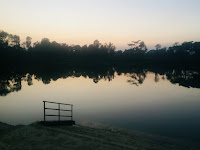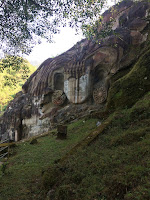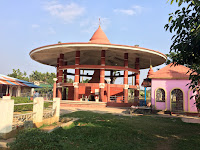Enamored since our first trip to Pachmarhi-Madhai-Bhopal, the state of Madhya Pradesh - Hindustan ka dil - beckons us to unravel its varied landscape of rich culture and natural bounty!
Delhi being very close to MP, we could make a very quick trip of the city of Gwalior of which I will now present a very crisp account.
Gwalior is famous for being the birthplace of Tansen, one of the nine jewels (Navratnas) of Emperor Akbar's court. Gwalior is also home to legendary singer Baiju Bawra and the wizard of Hockey - Major Dhyanchand.
Our trip and places we covered:
- Left New Delhi early in the morning by Bhopal Shatabdi at 6 am. It takes about 3 hours to reach Gwalior.
Gwalior Railway Station - Some of the major places of interest are scattered in the city and some are on the hilltop fort.
- We booked an Ola rental for the day and decided to first visit the city and later the fort. Visiting the hilltop later in the day would also allow you to witness the Light and Sound show at the Gwalior Fort which takes place in the evening.
- First stop was the Vivasvan Sun Temple. Now this is not really a very historic spot, being only about thirty years old - built by the Birlas. However, it is a near perfect replica of the Sun Temple at Konark. May be visited, if you've not been to the original, but do not spend more than half and hour here. Not a place of my interest!
- Next we visited the Tomb of Tansen(or the Tansen Memorial) and that of his Sufi master Mohd. Ghous Mohammad. These places need to be better maintained by the state Tourism. The two mausoleums - of intricate lattice designed walls- stand side by side in a park. The place is overgrown, the Monuments in want of upkeep and urchins and local vagabonds create a ruckus. The garden should be more well-manicured , more security personnel should be deployed so that tourists are not skeptical - if required, an entrance fee may be charged to permit entry to those who are truly interested. The Tomb of Tansen, till date, has an Imli tree, the leaves of which, if eaten, grants miraculous power of mellifluence. The Tansen Music Festival or the Tansen Samaroh is celebrated every year around December at this place.
Tansen Memorial - The Jaivilas Palace, constructed by Maharaja Jayaji Rao Scindia in 1874 at a cost of Rs 1 crore, currently houses the Scindia Museum and a part of it also serves as the residence of the former royal Maratha Scindia dynasty. This Palace is a fine example of European architecture. It has several galleries on the ground floor- the Scindia Lineage Gallery, Uniforms, carriages and even an indoor swimming pool. The first floor has several period Art rooms and one dedicated to the most popular modern day Scindia - Madhavrao Scindia. The most famous portion of the Jaivilas Palace is the Durbar Hall Complex, which has famed silver toy train serving food at the Banquet Hall table! Photography is prohibited inside the Jaivilas Mahal. The musuem will easily take about an hour
and a half to two.The Jaivilas Mahal - Searching the high rated restaurants in Gwalior, lunch followed at the Kwality Restaurant. Normal fare, value for money! The restaurant was hosting a farewell get-together of a school teacher that afternoon.
- Post lunch, we headed to the hilltop fort city. Gwalior Fort is an 8th century fortress, also popularly known as the "Gibralter of India" (why: just as Europe could not be won without winning Gibralter, the Southern part of India cannot
be accessed without passing through the Gwalior Fort). Here, one has to take the local vehicles available at the base of the hill to reach to the hilltop. So be prepared to shell out some more money here. On the way, there are huge Jain sculptures on the mountain walls reaching the Fort. The chief places of interest are :Gwalior Fort ahead - The Man-Mandir Palace: Magnificent, ceramic mosaics and lattice work.
Built by Maharaja Man Singh Tomar. Purchase tickets from the ASI counter and take a guide to visit the inner chambers to see the inner swimming enclave, communication network in the palace walls, and also the Jauhar Kund - where ladies gave up their lives, instead of being captive in war. Take a view of the sprawling city of Gwalior from the ramparts of the Man Mandir palace juxtaposed against the blue-green inlaid mosaic of the Fort walls! One of the vivid scenes symbolizing of the city of Gwalior. From the gates of the Man Mandir palace, we took an e-rick for a visit to the other places in the fort area.Man-Mandir Palace - The Shahastra Bahu Temple (or the Saas Bahu Temple) : Two temples - one in which the mother in law and the other in which the daughter in law used to worhsip Lord Shiva and Lord Vishnu. No worship is done here nowadays - in urgent need of maintenance - filled with bats and terrible stench. Suitable only for selfies and photography!
- The Teli ka Mandir : A huge temple - again where no worship is done and in need of maintenance. Said to be built by a merchant of oil - hence the name.
- The Suraj Kund : A pond , a dip in which is said to have cured the King Suraj Sen of leprosy. This place is also connected to the saint Galava, after whom the city of Gwalior is said to be named. The saint's blessings and the pond's water are said to have proven miraculous for the local King.
- The Scindia school : The Scindia School for boys is also in the Fort. One can catch the boys playing football or horse-riding in the playgrounds!
 |
| Saas Bahu Temple |
 |
| Suraj Kund, Gwalior Fort |
What we missed:
- As we were scheduled to return that evening, we could not stay for the Light & Sound show at the Man Mandir Palace. But I have read on multiple websites, that it is a show worth the wait - in the rich baritone of Amitabh Bachchan- it tells the tale of Gwalior city.
- Gurjari Mahal Musuem : Entrance at the base of the fort, on the opposite side. Was closed by the time we reached. Said to be build for the Maharaja for his beloved Gujjar wife Mriganayani. Please ensure, you visit this museum by 3 or 4 pm as it shuts down after that.
- Tigra Dam : About 25 km from the city. Can't comment much, as we did not go there. But in case, you are planning a two-day trip, may think of including this in your itinerary as well.
 |
| RKM Ashrama, Gwalior |
Our train back to Delhi was the same Bhopal Shatabdi at 7.45 pm which reaches around midnight!
What a packed but great visit!
Thank you, dear visitor, for reading this blog!
Looking forward to your comments on the same! :D





































